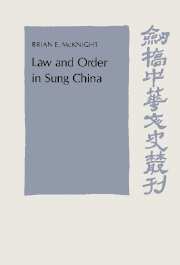Book contents
- Frontmatter
- Contents
- List of figures, maps, and tables
- Preface
- List of abbreviations
- 1 Introduction
- 2 The historical context
- 3 Crimes and criminals
- 4 Informal and semiformal agencies of law enforcement
- 5 Formal civil agencies of law enforcement
- 6 The role of the military in law enforcement
- 7 Supervision of law enforcement – the role of the intendants
- 8 Personnel selection
- 9 Urban crime and urban security
- 10 The Sung penal system
- 11 Jails and jailers in the Sung
- 12 Penal registration
- 13 The death penalty
- 14 Modifications of penalties
- 15 Conclusion
- Glossary
- Bibliography
- Index
9 - Urban crime and urban security
Published online by Cambridge University Press: 23 December 2009
- Frontmatter
- Contents
- List of figures, maps, and tables
- Preface
- List of abbreviations
- 1 Introduction
- 2 The historical context
- 3 Crimes and criminals
- 4 Informal and semiformal agencies of law enforcement
- 5 Formal civil agencies of law enforcement
- 6 The role of the military in law enforcement
- 7 Supervision of law enforcement – the role of the intendants
- 8 Personnel selection
- 9 Urban crime and urban security
- 10 The Sung penal system
- 11 Jails and jailers in the Sung
- 12 Penal registration
- 13 The death penalty
- 14 Modifications of penalties
- 15 Conclusion
- Glossary
- Bibliography
- Index
Summary
Introduction
The preceding chapters have described the law-enforcement system of the Sung dynasty, principally as it operated in rural areas and small towns. The pattern of law enforcement, and the related aspects of maintaining security in the larger cities of Sung times, differs in a number of significant ways from the pattern in rural areas. The most striking change initiated by the Sung was a renewed emphasis on the use of civil officials, mainly the sheriffs, in maintaining order in rural areas. They were responsible for law enforcement in both the district towns and the surrounding countryside. However, in the cities of the Sung there was greater continuity from the practices of the T'ang and earlier and a concomitant reliance on the military as the principal agents in maintaining law and order.
District towns were often quite small. In them the sheriff was the most important official concerned with law and order; the prefectural seats, usually larger urban centers than the district towns, also were the headquarters of army units that could be called on for law enforcement. Civilian sheriffs might also contribute, because the prefectural city was usually also the location of a district government with a sheriff on its staff, but the military were the dominant group. In the Sung some of the prefectural cities were quite large, forming part of a hierarchy of urban places culminating in the capitals, which were among the largest and most sophisticated cities in the world of that time. Much of our information on urban crime and law enforcement pertains to these capitals, Kaifeng and Lin-an.
- Type
- Chapter
- Information
- Law and Order in Sung China , pp. 283 - 320Publisher: Cambridge University PressPrint publication year: 1992

